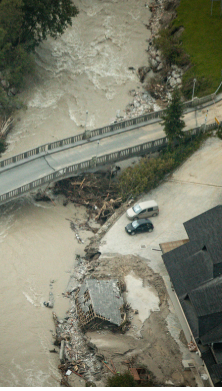- Safety improvement belies volume and magnitude of claims
- More sophisticated technology is driving higher values and cost of repairs
- Grounding cases more costly
- Growing potential for larger liability awards
- Foreign object damage claims and bird strikes soar
- Mis-fueling claims on the rise
The 1 minute dialogue
Safety improvement belies volume and magnitude of claims
Despite the significant improvements that have been made to the aviation sector’s safety record in recent decades – particularly with regards to the number of fatal accidents – the aviation insurance industry continues to see a high volume and growing magnitude of claims, meaning both aviators and insurers cannot afford to rest on their laurels. Foreign object damage, engine claims, ground collision incidents, slips and falls, groundings, mis-fueling incidents, as well as a trend for larger liability awards, are just some of the areas in which insurers are seeing heightened loss activity.
"The sheer volume and magnitude of claims handled by aviation insurers is often under- appreciated,” explains Dave Warfel, Regional Head of Aviation, North America at AGCS. “At any one time Allianz alone will handle thousands of claims from the airline industry, airports and manufacturers. Many of these claims will be slips and falls, but even these can be very expensive.
A concern is that the headline improvements in safety could lull the airline industry into a false sense of security. Thankfully, fatal air accidents for western-built jets are now infrequent, but the number of dollars paid in claims in recent years outstrips total insurance premiums.” And that is even before you consider recent large losses like the Ethiopian Airlines and Lion Air crashes, and the subsequent grounding of the Boeing 737 Max, which is likely to be one of the biggest aviation manufacturing losses in history.

ABOUT THE INFOGRAPHIC: Top causes of loss - Aviation claims: Based on analysis of 51,867 aviation insurance industry claims worth more than €14.8bn ($16.3bn) over the past five years, unsurprisingly collision/crash incidents account for over half the value of all claims (57%) by value – equivalent to €8.4bn ($9.3bn) – and over a quarter by number (27%). This means that there have been 13,638 aviation collision/crash incidents resulting in claims over the past five years.
Such incidents do not just include major crashes in the air, however. They also incorporate events like hard landings, bird strikes and runway incidents such as incursions and excursions. Between July 2013 and the end of 2018 the analysis shows there were 470 runway incidents resulting in aviation insurance industry claims causing in excess of €800mn ($883mn) of damages/losses. The average claim totals in excess of €1.7mn (€1,724, 029) ($1.9mn). Most of the incidents were related to damage caused by over- and under-shooting the runway/taxiway, including collisions with fences, signs, ground equipment and even vehicles on the runway.
Source: Allianz Global Corporate & Specialty. Based on analysis of 51,867 aviation insurance industry claims worth approximately €14.8bn between July 2013 and December 2018.
“An airline may not have experienced a large loss, but that does not mean that the industry is completely safe,” says Warfel. “There are still risks. For every airline incident that makes the headlines, there are probably 10 or 20 that don’t make it into the news, but are equally as challenging from a claims handling perspective and that are very expensive. Last year, for example, a fire during maintenance caused a $20mn loss, yet the incident would have gone largely unnoticed by the industry.”
Overall, aviation insurance claims are increasing in frequency and severity, a reflection of higher values, increased repair costs and rising liability awards. The volume of claims is also a reflection of growth in air transport, with increased passenger numbers and more congested airports, as well as growing demands on airlines, manufacturers and ground services.
“The frequency of claims has been rising, keeping pace with the global increase in air traffic. Each year more people are flying and we see a correlation between passenger numbers and claims, such as slips and falls in airports and damage to aircraft from ground operators,” says Warfel.
Headline improvements in safety have helped drive down the cost of insurance for airlines and manufacturers, but given the ongoing frequency of attritional claims, and rising severity, this means the industry’s annual claims total outstrips its annual premium.

“The cumulative impact of loss events around the world adds up to a big number and easily eclipses the cost of large losses,“ says Warfel. “Whether it is small bodily injury claims, bird strikes or ground accidents, the frequency of rate of aviation claims is as large as ever.”
According to AJ Gallagher Aerospace, worldwide airline passenger numbers increased by 139% between 2003 and 2017, while worldwide airline hull and liability premiums reduced by 64%. This equates to an 85% cut in the cost of insurance per passenger.
More sophisticated technology is driving higher value and cost of repairs
The increasing sophistication of new generation aircraft is leading to more expensive aviation insurance claims. In particular, more complex engines and new materials can be costly and more time-consuming to repair, driving up the cost of repairs and groundings.
Aircraft values have increased significantly in recent years, a reflection of more sophisticated engines and the growing use of composite materials in airframes. “A modern Boeing 777 or 787 can cost many millions of dollars and can be very expensive to repair,” says Warfel. The value of these types of aircraft can easily exceed $100mn.
Repair costs for new generation aircraft are now much higher than their predecessors. Modern engines, in particular, are increasing in value. “We recently handled a claim where a rental engine was required while the aircraft’s engine was repaired. The value of the rental engine was more than the entire aircraft, including its original remaining engine,” explains Dave Watkins, Regional Head of General Aviation, North America at AGCS.
Composite materials – such as carbon fiber layers bonded with resin – are strong and light, and therefore help improve fuel efficiency. However, the claims experience has revealed a higher repair cost associated with composite materials, which are generally more expensive to manufacture than traditional metal alloys, more labor intensive to repair and often require a larger repair area.
“More and more aircraft are using composite materials. Minor damage to composite aircraft can be easier to repair and is not expensive, but larger damage is more expensive to repair in composite materials than traditional metal alloy,” says Cadillat. Changes in manufacturers’ business models, as well as technical and regulatory considerations, are also affecting the cost of repairing engine and aircraft damage. As a result, insurers are seeing a trend towards replacement, rather than repair, of damaged aircraft components. Manufacturers have shifted their focus away from repairs in favor of selling new parts and components, while repair and inspection protocols have become increasingly burdensome, according to Watkins.
“We have had claims where manufacturers are not willing to signoff repairs to composite airframes due to liability concerns, or where repair protocols are just too burdensome. We recently had a claim where an aircraft wing was damaged during maintenance. However, the manufacturer’s repair and inspection protocols meant repair was not cost-effective. The result was a new wing, costing $10mn,” says Watkins.
Increased complexity and changes to manufacturers’ business models are also leading to longer repair times. “Some engines types are almost impossible to replace,” says Warfel. Manufacturers can also take much longer to inform insurers whether damage can be repaired and what is required than in the past.
“The time it takes to get an aircraft back into service has increased significantly. This has implications for insurers, but it has a massive impact on the airline that needs to find an alternative engine or aircraft,” says Warfel. "When an engine needs to be repaired, it may have to go back to the original manufacturer or an authorized repair facility, which creates a bottleneck and drives up cost. An airline may have to wait six months just to get in the line for repair.”

Grounding cases more costly
“While technology has helped drive big improvements in airline safety, the increased complexity of aircraft design and manufacturing has also led to an increase in costly grounding claims for insurers,” explains Axel von Frowein, Global Product Leader Aerospace at AGCS.
For example, the introduction of new aircraft and technology can lead to unexpected problems, grounding entire fleets. When the Boeing 787 Dreamliner was launched in 2013, a number of aircraft suffered from electrical system problems stemming from the lithium-ion batteries, causing the Federal Aviation Administration (FAA) in the US and airlines to ground the aircraft.
“Civil aviation and airline safety certification authorities have grown increasingly cautious. While the principle of precaution is welcomed from a safety perspective, it is likely to result in more, and longer, groundings of aircraft. Increasingly, we see aviation authorities are more demanding and careful, which they should be, and will continue to be,” says Saillard.
The redesigned Boeing 737 Max was grounded in March 2019 after two of the newly delivered aircraft crashed within five months. Investigations into the Lion Air and Ethiopian Airlines accidents are ongoing, but they have highlighted potential risk considerations for technical innovation in the industry. While the causes of the two 737 Max crashes are not fully known at the time of writing, attention has focused on the interaction of the pilots with the aircrafts’ autopilot systems. In a bid to increase efficiency, Boeing changed the engines on the 737 Max, putting larger engines on an old aircraft design, requiring a software workaround, known as the Maneuvering Characteristics Augmentation System (MCAS). The pilots were reportedly unable to regain control of the aircraft after the MCAS repeatedly forced the aircraft to descend.
The grounding of the Boeing 737 Max, one of the fastest selling aircraft of all time, is likely to lead to one of the biggest airline manufacturers claims to date. The grounding has resulted in a large financial loss for the aircraft’s manufacturer and airlines. It has been reported that Boeing has put aside almost $5bn to compensate airlines [1], a number of which have announced plans to cut routes and staff in response to the grounding and delays to aircraft on order.
“Such incidents highlight the challenge in finding technical solutions to complex problems, which increases the time it takes to get grounded aircraft back into operation,” says James Van Meter, Aviation Practice Leader, North America at AGCS. “Even after a fix is developed and certified, the task of retrofitting a fleet will take a considerable amount of time. Grounded aircraft also require a tremendous amount of maintenance and upkeep to ensure they remain in an airworthy condition.”
Although, the grounding of the 737 Max is likely to result in a large claim for aircraft manufacturers’ insurers, the financial impact for airlines is largely uninsured. “Loss-of-use insurance cover has become increasingly relevant with the increased value of aircraft, and more importantly the revenue they represent to airlines,” says Warfel. “Yet loss of revenues for grounding aircraft is largely uninsured by the airlines, which do not typically buy grounding cover.”
Growing potential for larger liability awards
Liability claims per passenger have soared as US plaintiff attorneys aggressively seek higher awards from a wider range of incidents. Liability awards have risen dramatically. The rule of thumb for general aviation operators was $1mn to $3mn per passenger seat 10 years ago. Today, in certain circumstances, the numbers can be much higher than that. “With fewer major airline losses, plaintiff attorneys are fighting over a much smaller pool and are putting more resources into fewer claims, pushing more aggressively for higher awards and looking for more areas in which to seek compensation,” says Watkins.
Southwest Airlines, together with aircraft and engine manufacturers, are currently facing litigation following an incident last year in which a woman was tragically killed when an engine blowout shattered a window on a Boeing 737. The family of the deceased passenger started legal proceedings against the airline, while a number of passengers on the flight sought damages. The compensation pay-out from such events can easily be in the multi-millions of dollars.
Increased liability awards are a particular challenge at a time of growing passenger numbers and a trend towards larger aircraft. In a drive for efficiency, airlines are flying more passengers, but on fewer flights. According to the Bureau of Transportation Statistics, the average number of US passengers per flight jumped from 69 to 91 between 2007 and 2017.
The new generation of aircraft carry hundreds of passengers at one time – the Boeing Dreamliner can carry 250 to 300 passengers while an Airbus A380 has capacity for around 600. With liability awards per passenger in the millions, a major aviation loss could easily result in a liability loss of $1bn.
Foreign object damage claims and bird strikes soar
Ten years ago this year, US Airways Flight 1549, en route from New York’s LaGuardia Airport to Charlotte, North Carolina, demonstrated all too well the dangers of birds within the immediate vicinity of operating aircraft. The Airbus 320-214 had to make an emergency landing in the Hudson River after a flock of Canadian geese severely damaged both engines. Fortunately, all 150 passengers and crew survived and the so-called “Miracle on the Hudson” was later turned into a film Sully with Tom Hanks as the plane’s captain.
A decade later – in August 2019 – and in the so-called “Miracle over Ramensk” – a Russian passenger plane had to make an emergency landing in a cornfield near Moscow after striking a flock of birds, demonstrating that one notable area which is still posing a significant threat to flight safety and driving frequency of claims is damage to aircraft and engines from foreign objects, such as stones, misplaced tools and most commonly wildlife or bird strikes.
“Damage from foreign objects like bird strikes is nothing new in aviation, but we are seeing a high level of foreign object damage claims,” says Warfel.

For example, there were more than 14,600 reported collisions with wildlife in 2018, according to Federal Aviation Administration (FAA) data [2]. That equates to an average of 40 bird strikes per day in the US.
According to AGCS analysis of more than 50,000 aviation insurance claims, bird strikes are a notable contributor to aviation collision/crash incidents, resulting in excess of €330mn ($364mn) of insured damages between July 2013 and the end of 2018 – over 1,000 (1,032) related claims were received by insurers during this period in this data set. The average bird strike claim costs €327, 232 ($361,356) with some claims costing as much as €15mn ($16.6mn) and up. Most accidents occur when birds hit windscreens or fly into engines.
Estimates of the economic toll of bird strikes have been calculated at as much as $400mn a year in the US alone to $1.2bn worldwide, although conclusive numbers are hard to come by. Attempts are being made to further reduce the number of strikes on take-off and landing at airports through bird management and control. Many airports have implemented wildlife management plans and employ wildlife biologists to help safely move encroaching wildlife out of harm’s way. Other approaches include utilizing sounds, lights, pyrotechnics, radio-controlled airplanes, decoy animals, lasers, dogs and bird capture and relocation methods. However, population increases in flocking birds, together with the growth in commercial air traffic, continue to pose challenges.

Mis-fueling claims on the rise
Mis-fueling of aircraft can result in costly damages, but it can also have potentially catastrophic consequences. With so many different types of aircraft in operation using different fuels and additives, human error is a real risk. AGCS has seen a growing number of mis-fueling claims where mistakes made by ground crews have resulted in costly repairs and lengthy groundings.
“We have seen a number of incidents of mis-fueling that have resulted in damage to aircraft and grounding. This is an issue that is not receiving enough attention,” says Watkins. “We have had claims where ground handlers have put jet fuel in piston aircraft and vice versa. There have also been a series of diesel exhaust fluid (DEF) contamination incidents, where an incorrect additive has been unintentionally introduced into the aircraft, which can cause fuel system and engine damage, and in some cases, actually cause jet engines to shut down in flight. We had one particularly large claim where the whole fuel system had to be replaced, grounding the aircraft for a number of months."
[2] USA Today, Planes Strike Birds More Than 40 Times A Day, FAA Data Shows
This article is part of the report "Aviation Risk Report 2020" which focuses on safety developments in commercial aviation around the world. It identifies a number of insurance claims trends which are impacting the industry – including the top causes of financial losses – and highlights a number of risk trends and challenges that will impact the aviation sector and insurance landscape in future.
The findings have been produced with the assistance of Embry-Riddle Aeronautical University, the world’s largest fully-accredited university specializing in aviation and aerospace.















